Ever wonder how to make a small living room feel spacious, stylish, and totally functional? As urban living spaces shrink and apartment living becomes more popular, designing small living rooms that maximize every inch has never been more in demand. These clever spaces aren’t just about fitting furniture; they’re about creating an inviting, efficient environment that reflects your personality without feeling cramped. Small living rooms can be full of character and practical brilliance—if you know the right tricks!
In this article, you’ll discover a treasure trove of inspiring ideas and practical solutions to transform compact spaces into cozy, organized retreats. From innovative furniture choices to smart storage hacks, we’ll cover a variety of design tips that balance style and functionality perfectly. Whether you’re looking for minimalist elegance or playful accents, get ready to unlock the potential of your small living room with ideas that are as creative as they are effective!
1. Multi-Functional Furniture for Compact Living Rooms
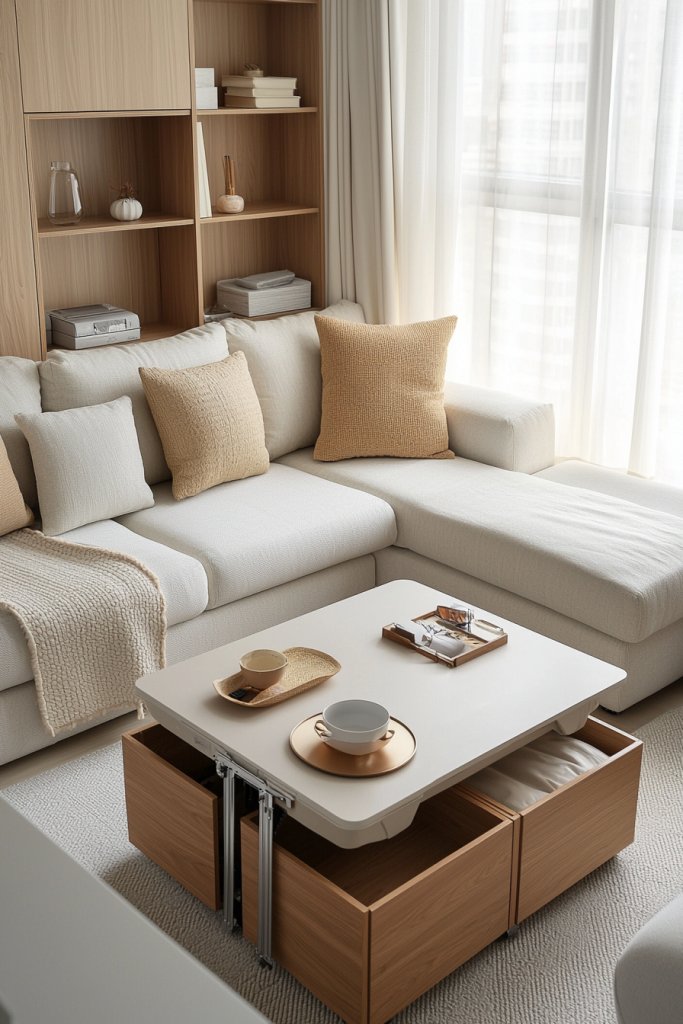
Maximizing space in a small living room often hinges on clever furniture choices that serve multiple purposes, making every square inch count. This approach not only saves room but also simplifies decor by reducing clutter, creating a sleek, cohesive look.
Imagine a sleek sofa bed with a plush, neutral fabric that pulls double duty as a cozy seating area during the day and a comfortable bed at night. Or think of an ottoman with hidden storage, upholstered in a soft, textured fabric like chenille, filled with magazines, throws, or even extra pillows. A fold-out wall desk can transform from a stylish surface into a workspace when needed, finished in light wood tones that brighten the space. These versatile pieces often feature clean lines and modern designs, seamlessly blending function with style. The overall ambiance feels open, organized, and welcoming, with each piece contributing to both form and function.
To implement this, start by selecting furniture with built-in storage options, such as a sofa with drawers or storage beds. Look for pieces in lightweight materials like birch plywood or metal frames to keep the space feeling airy. For DIY enthusiasts, repurposing an old trunk as a coffee table or adding removable cushions to convert a bench into a bed are simple, budget-friendly projects. Keep the layout open, placing larger multi-purpose items against walls to maximize walking space. With thoughtful choices, your small living room can be both stylish and supremely functional.
2. Vertical Storage Solutions to Free Up Floor Space
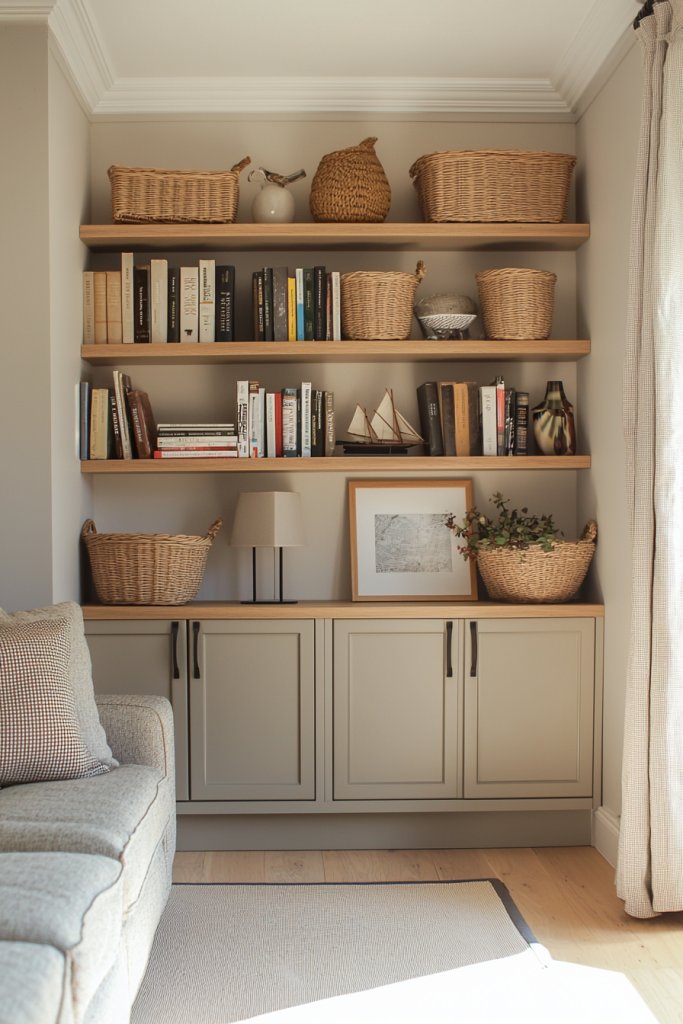
In small living rooms, vertical storage is your best friend—think upwards rather than outwards—to keep the floor clear and the room feeling spacious. Installing shelves, cabinets, or wall-mounted units creates valuable storage without sacrificing style or space.
Picture a wall lined with floating shelves in a matte black or warm wood finish, displaying books, ceramics, or decorative objects like sculptures and vases. These shelves are staggered or aligned neatly, drawing the eye upward and adding visual interest. Behind a sofa, tall, slim storage cabinets in a light hue or with glass doors can hide clutter while maintaining an open feel. Using corner wall shelves effectively utilizes awkward spaces, providing spots for small plants, picture frames, or baskets. The overall effect is a clean, organized space that feels less cramped, as the eye is naturally drawn upward, creating a sense of height and expansiveness.
To bring this idea to life, start by measuring your wall spaces and selecting modular shelving units or custom-built niches that suit your style. Use wood, metal, or acrylic materials depending on your aesthetic preference and budget. For easier installation, opt for pre-made wall brackets and screw-in shelves available at hardware stores. To keep clutter at bay, add storage baskets or boxes on shelves for smaller items. The key is to keep the design sleek, organized, and visually appealing, turning vertical space into a highlight rather than a storage afterthought.
3. Light Color Palettes to Create an Airy, Open Feel

Choosing a light color palette is one of the most effective ways to make a small living room feel larger, brighter, and more inviting. Soft, neutral shades reflect natural light and create an illusion of space, transforming even the smallest rooms into airy retreats.
Visualize a living room painted in soft ivory or warm beige, complemented by white or cream curtains that diffuse sunlight throughout the space. The furniture—like a twill fabric sofa in a light gray or pastels—adds to the light, calming atmosphere. To enhance the open feel, incorporate light-colored rugs with subtle patterns and textures, such as a plush, cream-colored shag or a woven jute. Textiles like cushions and throws in muted tones with tactile textures (think chunky knits or linen) add warmth without heaviness. Bright, reflective surfaces such as glossy coffee tables or mirrored accents amplify the light, making the room feel more spacious. The overall vibe is fresh, clean, and uncluttered, with a soothing visual flow.
To implement this, start by choosing a neutral paint color and keep furniture in similar shades or light woods like birch or ash. Incorporate white or pastel textiles for window treatments, cushions, and upholstery. Use multiple light sources—like table lamps and wall sconces—to enhance brightness, especially in rooms with limited natural light. Avoid heavy dark-colored furniture or bold patterns that can make the space feel smaller. By sticking to a cohesive, light color scheme, you’ll create a versatile backdrop that feels open, airy, and welcoming every day.
4. Floating Shelves for Stylish and Space-Saving Display
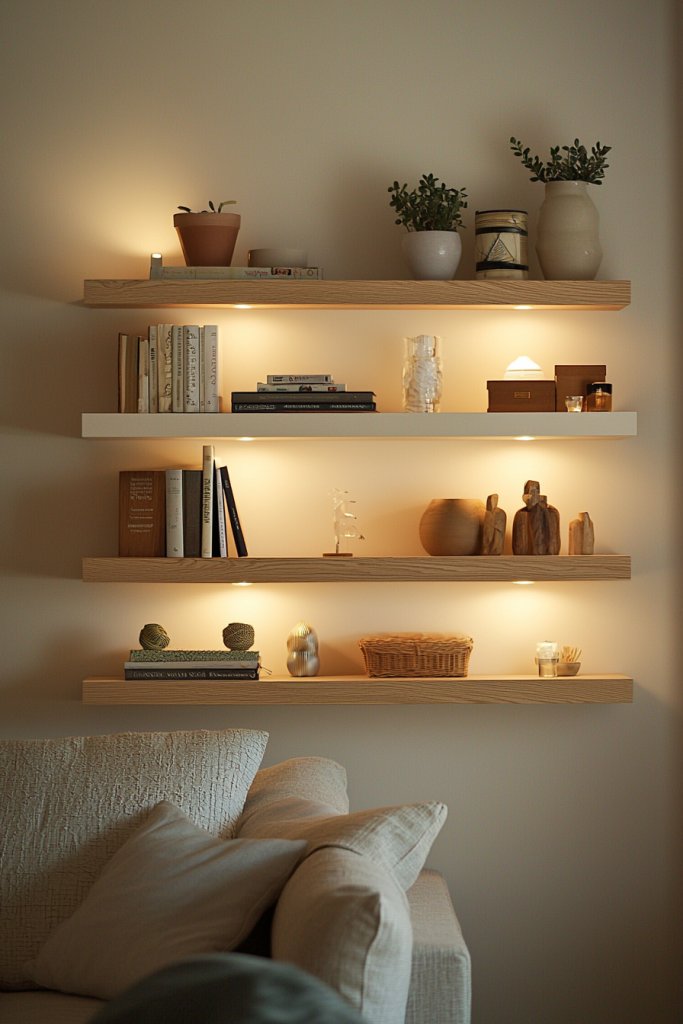
Floating shelves are a sleek, modern solution for small living rooms, offering the perfect blend of practical storage and stylish display without taking up precious floor space. Their minimalist design adds visual interest while keeping surfaces clear and open.
Imagine a wall decorated with narrow, matte black floating shelves holding a curated collection of ceramic vases, small sculptures, and framed photos. The open design makes the room feel less crowded, and the floating effect creates a sense of depth and dimension. These shelves can be arranged asymmetrically or symmetrically depending on your style, adding personality without clutter. Complemented by light-colored walls and soft lighting, they serve as both storage and focal points that elevate the overall decor. The tactile contrast of smooth ceramic, textured textiles, and glossy frames against the floating surface enhances the sensory experience, making the space feel thoughtfully curated yet uncluttered.
Getting started is simple: purchase pre-made floating shelf kits from hardware stores or online, choosing materials like wood, MDF, or acrylic based on your aesthetic. Use a level and measuring tape to ensure precise placement, and secure shelves with appropriate anchors for weight-bearing items. Decorate with a mix of small decorative objects and essential items to keep the display balanced. The key to success is moderation—displaying only a few select pieces that complement your color palette and style, allowing your small living room to feel open and inviting with minimal effort.
5. Mirrored Walls and Furniture to Enhance Light and Perception

Mirrors are a classic trick for small spaces, instantly amplifying light and creating a sense of depth. Strategically placed mirrored walls or furniture reflect natural and artificial light, making your living room look brighter and more expansive.
Visualize a living room with a large floor-to-ceiling mirror behind the sofa, framed in a sleek, slim black or metallic border. This mirror reflects sunlight streaming through the window, bouncing it around the room, while visually doubling the space. Complementing this, a glass coffee table with a transparent acrylic base offers a modern touch that doesn’t obstruct sightlines, and a mirrored sideboard adds storage while reflecting the decor. The overall environment feels more open, with light bouncing effortlessly across surfaces, elevating the sense of airiness and spaciousness. The textures and reflective surfaces work together to create a bright, inviting ambiance that feels larger than life.
To implement, choose a large mirror that fits your wall space—consider options like wall-mounted, adhesive-backed, or lean-to styles for flexibility. Pair it with furniture in light, glossy, or metallic finishes to maximize the reflective effect. Position mirrors opposite windows or in areas where they can catch light, avoiding clutter nearby that might detract from their impact. Keep the surrounding decor simple and uncluttered, allowing the mirror to do its magic. With a few strategic placements, your small living room will feel transformed into a brighter, more open sanctuary.
6. Compact Sectional Sofas with Built-In Storage
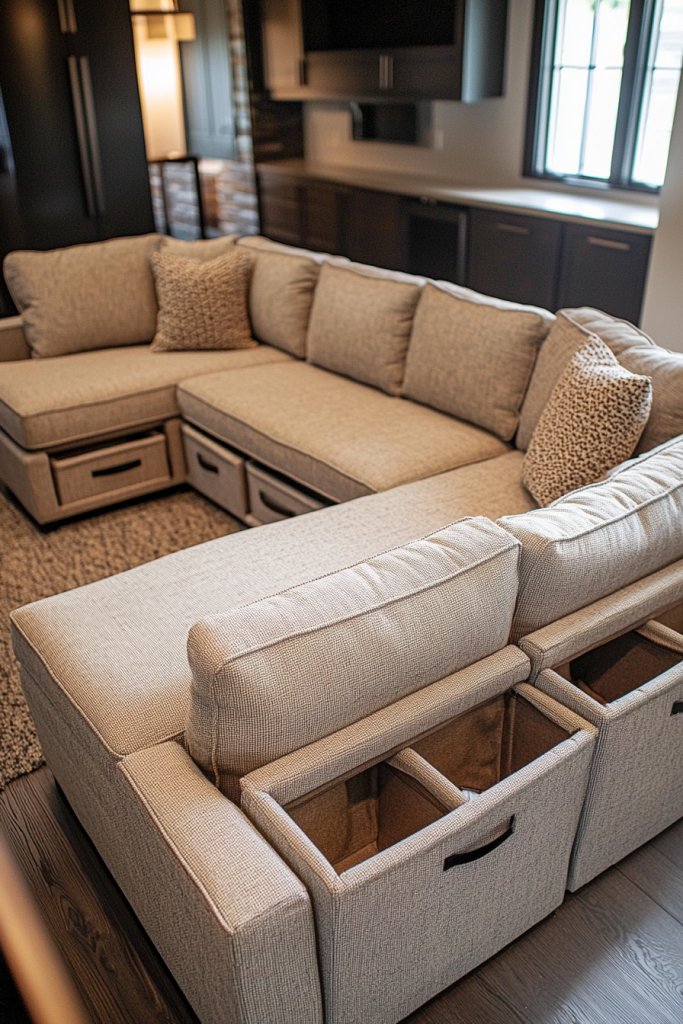
A compact sectional sofa with built-in storage is a game-changer for small living rooms, combining comfort with practicality to maximize every inch of your space. It’s the perfect solution for those who want to relax without sacrificing valuable storage or clutter control.
Imagine a sleek, low-profile sectional in a soft, neutral fabric like dove gray or warm beige, with plush cushions inviting you to settle in comfortably. Beneath the seating, discreet drawers or lift-up ottomans hide away blankets, magazines, or even shoes, keeping everything neatly out of sight. The upholstery has a smooth, matte finish that feels cozy to the touch, while the clean lines and modular design give the room a modern, uncluttered vibe. Accents like textured throw pillows, a chunky knit blanket, or a small decorative sculpture add visual interest without overwhelming the space, making the entire area feel inviting and well-organized.
To bring this idea to life, start by choosing a compact sectional with built-in storage options or consider adding storage benches or ottomans that complement your existing furniture. Look for options in durable, easy-to-clean fabrics like microfiber or performance velvet—alternatives include faux leather or linen blends. Measure your space carefully to ensure the sofa fits comfortably, leaving enough room for movement. Assembling a sectional with storage can often be done with minimal tools, and many stores offer customizable pieces. A few decorative textiles, such as a soft throw blanket or patterned cushions, will complete the look, creating a cozy yet functional living area that feels spacious and organized.
7. Hidden Storage Ottomans for Clutter-Free Living
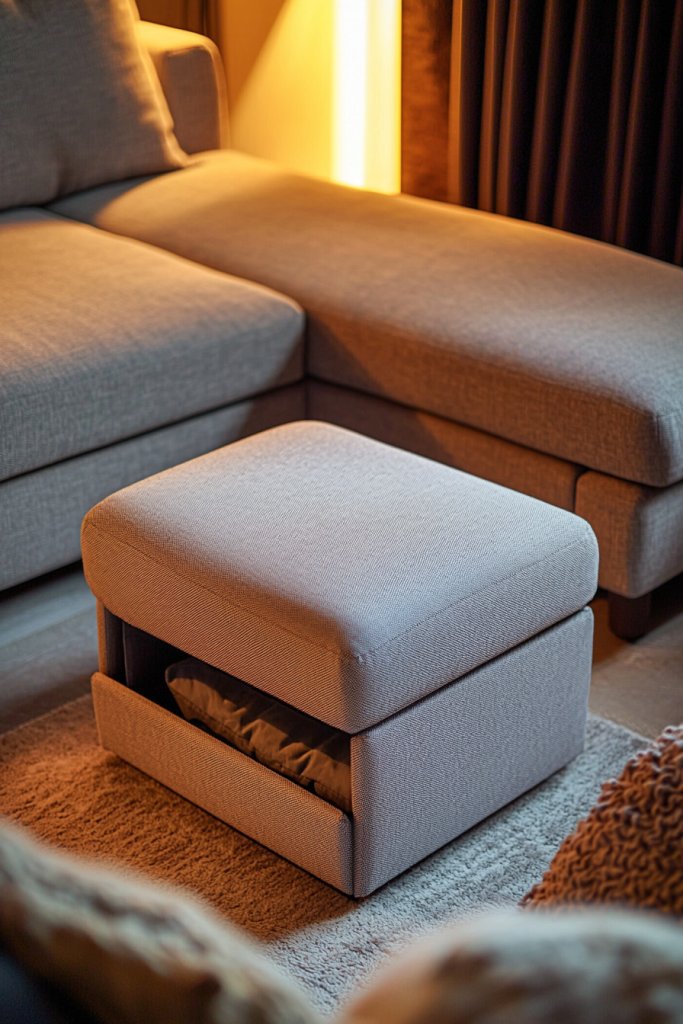
Maximize your small living room’s storage potential without sacrificing style by incorporating hidden storage ottomans—functional pieces that keep clutter out of sight while adding a touch of elegance. These versatile furnishings are perfect for making a compact space feel organized and spacious, allowing you to enjoy a tidy environment effortlessly.
Imagine a plush, rectangular ottoman upholstered in soft beige linen with subtle tufting, nestled comfortably at the foot of your sofa. Its top opens smoothly to reveal a spacious storage compartment, ideal for stashing blankets, magazines, or remote controls. The exterior’s neutral tones blend seamlessly with light-colored hardwood floors and pastel-colored cushions, creating a calm, inviting atmosphere. The textured fabric invites touch, while the hidden storage keeps the room feeling uncluttered and serene, enhancing the overall sense of openness and comfort.
To create your own hidden storage ottoman, start with a sturdy frame—either a pre-made storage ottoman or a DIY wooden box—and upholster it with your favorite fabric, such as soft linen, faux leather, or even a patterned textile for added flair. Attach a comfortable cushion top that lifts easily, secured with hinges or magnets for convenience. Fill the interior with your preferred items—blankets, toys, or books—and place it at the end of your sofa or chair. With a little DIY effort and thoughtful material selection, you’ll enjoy a stylish, clutter-free living space that maximizes every inch.
8. Tiered Coffee Tables for Additional Surface and Storage
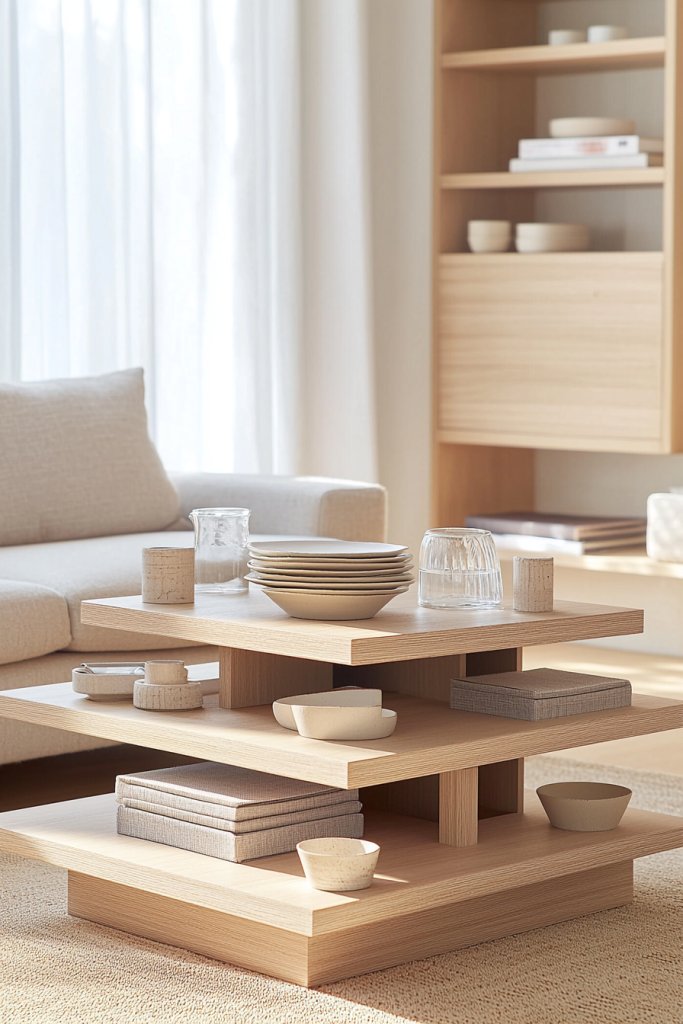
A tiered coffee table is a clever solution for small living rooms, offering both extra surface space and hidden storage without cluttering the room. It’s a game-changer for maximizing functionality while maintaining a clean, stylish look.
Imagine a sleek, multi-level table with a matte black metal frame and wood or marble surfaces in warm oak or cool marble gray. The top tier holds a cozy ceramic mug and a soft, textured throw blanket in neutral tones, while the lower shelf discreetly stores magazines, remote controls, or decorative baskets. The different heights create visual interest and make the space feel dynamic, while the layered surfaces invite touch and interaction. The overall aesthetic is modern yet inviting, with smooth textures and a balanced mix of materials that add warmth and sophistication to the room.
To create your own tiered coffee table, start with a sturdy base such as a metal frame with two or three tiers. You can find ready-made options at furniture stores or assemble a DIY version using reclaimed wood and metal piping. Secure the tiers with strong brackets or screws, and finish with a protective sealant if using wood. For a budget-friendly approach, stack sturdy wooden crates or use repurposed shelving units. Add decorative trays or small baskets on the top layer to keep essentials organized and accessible, turning your small living room into a neat, functional haven.
9. Use of Clear Acrylic Furniture for a Less Obstructive Look
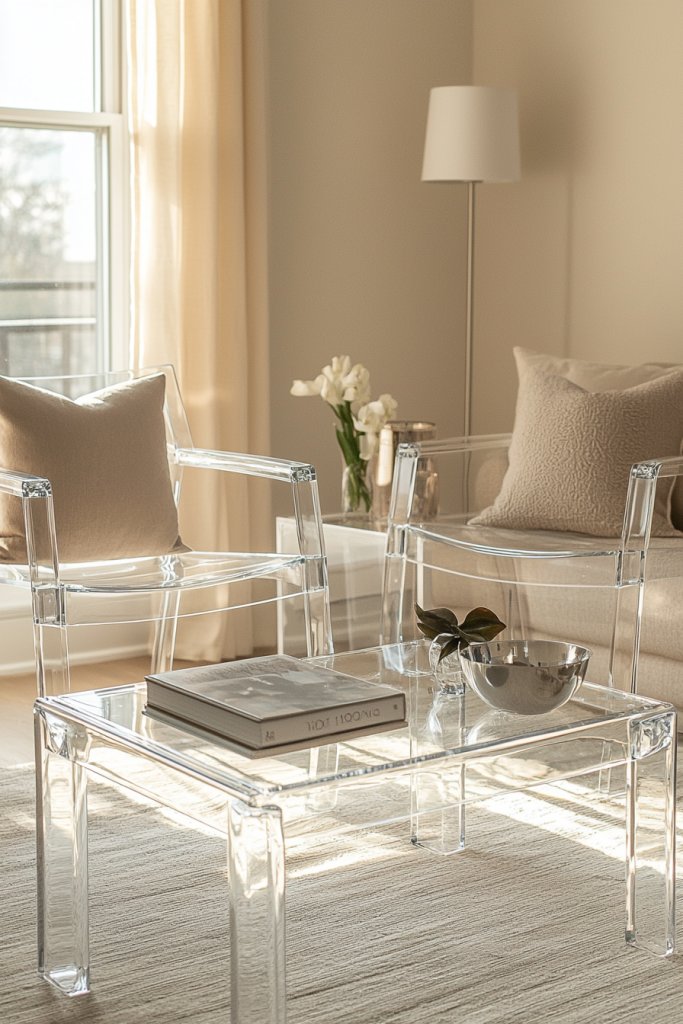
Using clear acrylic furniture is a game-changer for small living rooms, as it creates the illusion of more space while maintaining functionality and style. This clever choice helps your room feel open and uncluttered, making a cozy space appear larger and more inviting.
Imagine a sleek, transparent acrylic coffee table with smooth, rounded edges sitting effortlessly in the center of your living room, reflecting light and blending seamlessly with the surroundings. Pair it with transparent side chairs or a minimalist acrylic console, which almost disappear into the room, allowing your other decor and wall colors to stand out. The clear surfaces catch and reflect natural light, creating a bright, airy atmosphere, while the soft textures of textiles like plush throws or woven cushions add warmth and comfort. The overall look feels modern, fresh, and surprisingly spacious, with a sense of calm and openness that invites relaxation.
To recreate this look, start with a few key acrylic pieces like a coffee table and side chairs—these are widely available online or at furniture stores. If true acrylic isn’t within your budget, consider alternatives like glass or lucite furniture, which offer similar transparency and sleekness. Assemble your space by arranging these pieces in a way that keeps pathways clear and avoids clutter, enhancing the sense of openness. Add cozy textiles, such as a soft cream throw blanket or textured cushions, to balance the sleekness and bring warmth to the room. With a little shopping and thoughtful arrangement, you can achieve a stylish, spacious feel using clear acrylic furniture that’s both functional and visually unobtrusive.
10. Zone Segmentation with Rugs and Furniture Arrangement

Creating defined zones within a small living room can dramatically boost its functionality and sense of order, making the space feel larger and more inviting. Strategically separating areas ensures each part of your living room serves a clear purpose, whether for lounging, reading, or entertaining guests, without feeling cluttered or chaotic.
Imagine a cozy seating area anchored by a soft, neutral-toned rug with subtle geometric patterns that visually divide the space. In one corner, a plush beige sectional sofa invites relaxation, complemented by a textured throw blanket in warm caramel tones and a few decorative pillows in muted gold and deep navy. A sleek, round coffee table with a smooth wooden top and slender metal legs sits in the center, while a woven basket nearby holds magazines and cozy blankets. The arrangement creates distinct zones—one for lounging, one for conversation—while maintaining an open, airy feel. The gentle contrast of textures, from the plush rug to the smooth surfaces and soft textiles, enhances tactile interest and warmth.
To recreate this look, start by choosing a large area rug that clearly defines your seating zone—think soft wool or jute for natural warmth. Arrange your main furniture pieces, such as a sofa and chairs, around this rug to create a cohesive section. Add a coffee table in the middle, selecting a design that complements your style—wood for warmth, glass for a lighter feel. Incorporate decorative textiles like textured throws and cushions to add comfort and visual depth. Simple accessories like woven baskets or ceramic vases can help organize and elevate the space, making zone separation both functional and stylish with minimal effort.
11. Wall-Mounted TV and Media Units to Save Floor Space
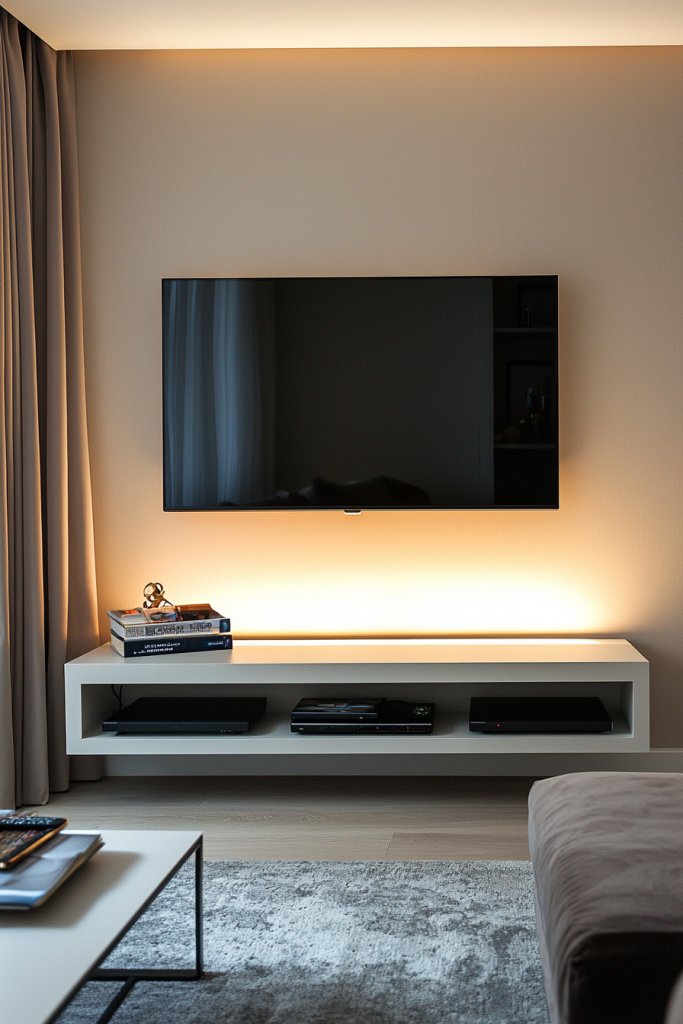
In small living rooms, saving as much floor space as possible is key, and wall-mounted TVs with sleek media units are a game-changer. They create a clutter-free environment, making the room feel larger and more open. Plus, they add a modern, streamlined look that enhances the overall aesthetic.
Imagine a slim, flat-screen TV mounted directly onto the wall, with a floating media console beneath it. The console might be a minimalist wooden shelf or a sleek lacquered unit in neutral tones like soft gray or matte black. This setup leaves the floor clear, allowing for easy movement, while a few decorative objects—like a ceramic vase or a small sculpture—add personality without clutter. The wall behind the TV can be painted in a light, reflective color to bounce light around and amplify the sense of space. Soft ambient lighting can further enhance the cozy, modern vibe.
Getting started is simple: first, choose a sturdy wall mount compatible with your TV size. Then, select a slim, wall-mounted media unit that suits your style—think floating wood shelves, lacquered panels, or sleek metal brackets with storage underneath. Use a level to ensure precise placement. Conceal wires using adhesive clips or cable management sleeves for a clean look. This setup is perfect for DIY enthusiasts and requires minimal tools—just a drill, level, and some cable management accessories. It’s a straightforward, stylish upgrade that maximizes every inch of your small living room.
12. Slim Profile Furniture for Narrow Living Rooms
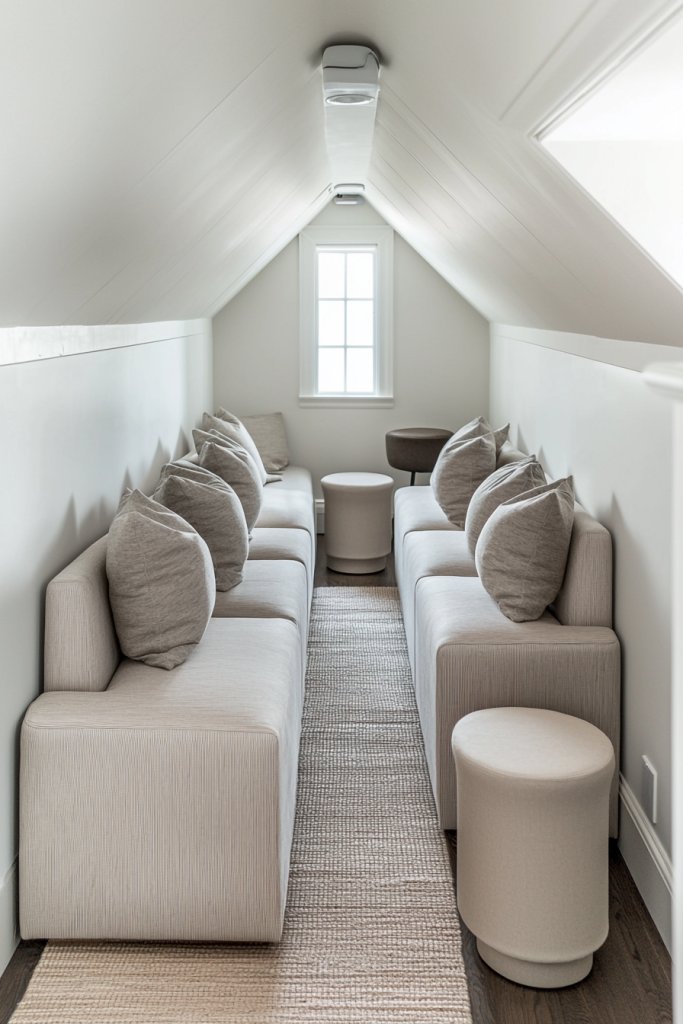
In narrow or tightly configured living spaces, furniture with a slim profile is essential to prevent overcrowding and maintain an open, airy feel. These pieces are designed to be space-efficient without sacrificing style or comfort, making your small living room feel larger and more functional.
Visualize a narrow sofa with slender legs and a sleek silhouette, upholstered in a soft, neutral fabric like beige or light gray. Accompany it with a compact, streamlined coffee table—perhaps a clear acrylic or a thin wooden slab on slim metal legs—allowing easy movement around the room. Opt for a slim, high-back armchair in a coordinating color to add seating without bulk. The furniture’s proportions create a balanced, uncluttered look, emphasizing vertical space and light. To add warmth, layer with textured cushions or throws in soft, muted tones, and incorporate a small, light-colored rug that extends slightly beyond the furniture edges, anchoring the space without overwhelming it.
To implement, choose furniture with narrow depths—generally less than 30 inches for sofas and chairs—and look for pieces with slim legs that elevate the design. Consider multi-functional options like a narrow console that doubles as a side table or storage unit. Measure your space carefully to ensure proper fit, and opt for lightweight furniture that’s easy to move. Many brands offer affordable, stylish options designed specifically for small, narrow rooms—perfect for creating an open feel without sacrificing comfort.
13. Clever Corners: Corner Sofas and Storage Units
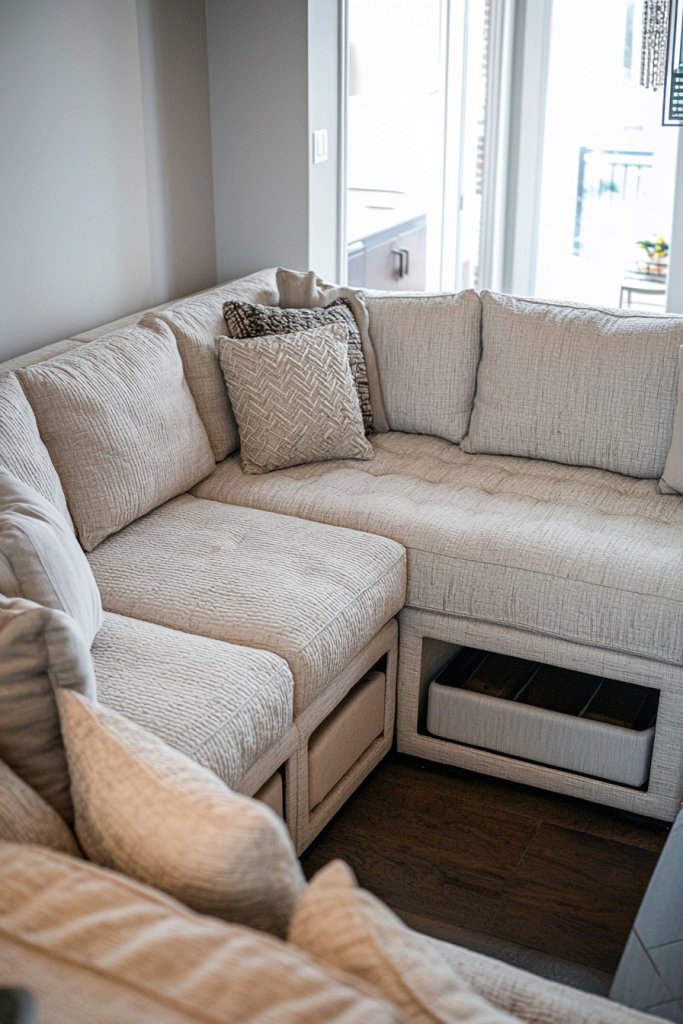
Corners are often underutilized in small living rooms, but with smart design choices, they can become functional focal points. Corner sofas and storage units maximize every inch of space, creating cozy, efficient zones within the room.
Picture a sleek, low-profile corner sofa upholstered in a soft, neutral fabric like taupe or charcoal. Its L-shape design fits snugly into the corner, freeing up the main area for movement and other furniture. Complement it with a small, multi-purpose corner shelving unit or a built-in niche for books, decorative objects, or even electronic devices. These elements add visual interest and storage without encroaching on the main space. The overall look is balanced and inviting, with layered textures such as a plush throw blanket draped over the sofa and some textured cushions for comfort. The arrangement creates a natural, intimate seating nook that feels both personal and spacious.
To recreate, measure your corner carefully to select a sofa that fits perfectly without overwhelming the space. Look for modular or customizable options that can be tailored to your room’s dimensions. For storage, consider corner shelves, built-in niches, or small cabinets that can be tucked into the corner for maximum efficiency. Use light colors and simple lines to keep the corner area from appearing crowded, and add a cozy throw or a decorative pillow to make it inviting. This approach turns an awkward corner into a stylish, practical feature that enhances your small living room’s comfort and utility.
14. Fold-Down Tables for Flexible Dining and Work Areas
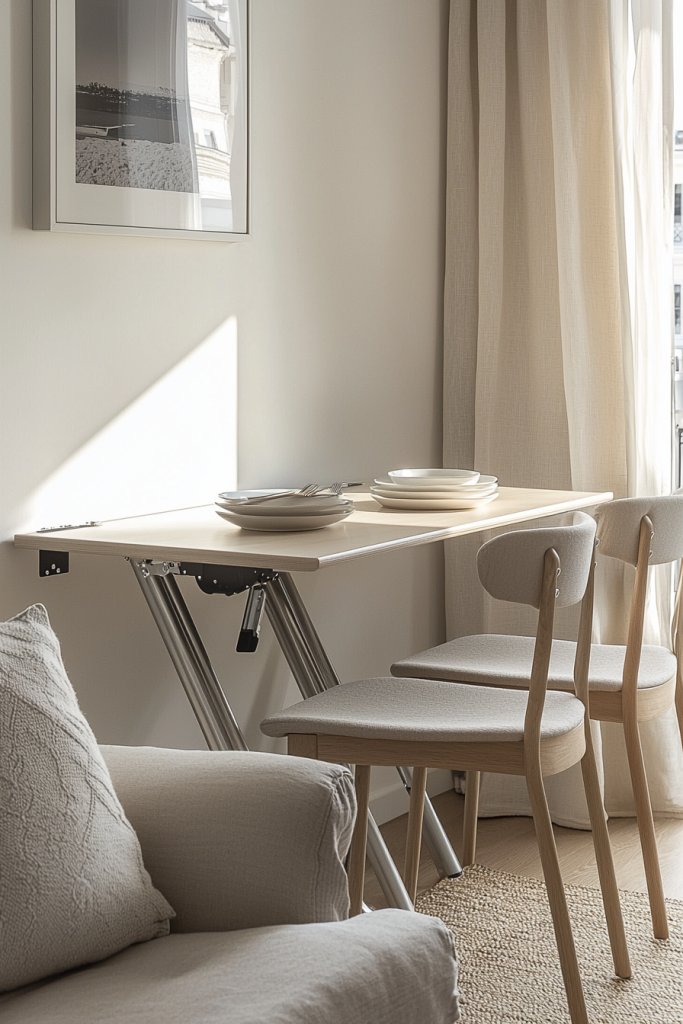
In small living rooms, multifunctionality is a must, and fold-down tables provide an elegant solution for dining, working, or crafting without permanently sacrificing space. They can be neatly tucked away when not in use, maintaining a clean, open environment.
Imagine a sleek wall-mounted table with a smooth, wooden surface in a light oak or white finish, attached to a sturdy hinge or collapsible brackets. When needed, pull it down to create a compact dining or work area, and fold it up when finished, revealing a clean wall or hidden storage behind. The table can be paired with fold-away chairs stored nearby or wall-mounted, foldable seating that can be easily stowed away. The design maintains a minimalist aesthetic, with the table sporting clean lines and subtle hardware. The space feels flexible and adaptable, perfect for quick meals or home office tasks, with a sense of openness maintained at all times.
Start by selecting a wall-mount table kit made from durable materials like wood or laminate. Attach the brackets securely to the wall, ensuring they can support the weight of your intended items. Use a level for proper alignment and consider adding a small shelf or hooks above for utensils, notebooks, or other essentials. When not in use, simply fold the table up to keep the space open, making it ideal for transforming your living room into a functional area in seconds. This DIY-friendly solution makes small spaces much more versatile and clutter-free.
15. Modular Furniture that Reconfigures for Different Needs
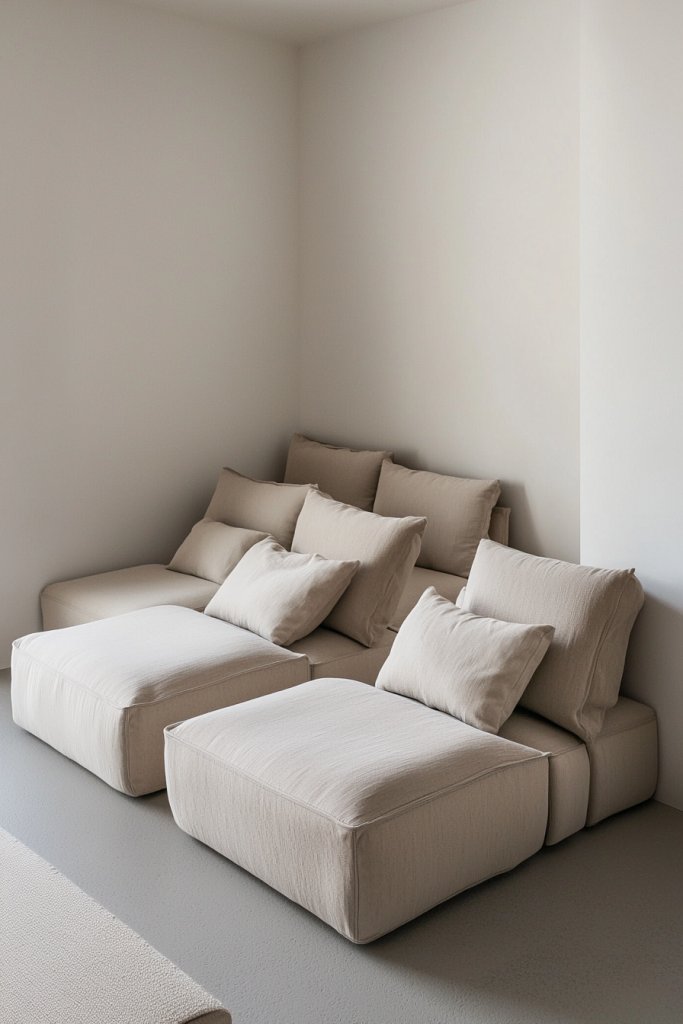
Modular furniture offers unmatched versatility for small living rooms, allowing you to adapt your space to various activities and layouts as needed. These pieces can be rearranged, expanded, or collapsed, making them ideal for maximizing efficiency.
Picture a set of modular sofa sections in neutral tones—think soft beige or light gray—that can be pushed together for a cozy seating area or separated into individual chairs for different zones. Add a modular coffee table with removable or adjustable components, like a nesting set of trays or a fold-out surface, to serve multiple functions. These pieces often feature hidden storage, such as ottomans with lift-up lids or hidden compartments, helping keep clutter out of sight. The overall aesthetic is clean and contemporary, with a focus on flexibility and minimalist style.
To implement, choose modular furniture with a simple, sturdy design that suits your space. Measure your room to ensure pieces can be easily reconfigured without obstruction. Look for options with lightweight frames or easy-to-move sections, and consider purchasing from brands known for durable, multi-purpose furniture. You can also DIY some modular elements using plywood, casters, and simple connectors. This approach allows you to customize your living room layout for movie nights, work sessions, or guest visits, all while keeping the space open and inviting.
16. Built-In Shelving and Niches to Maximize Wall Space
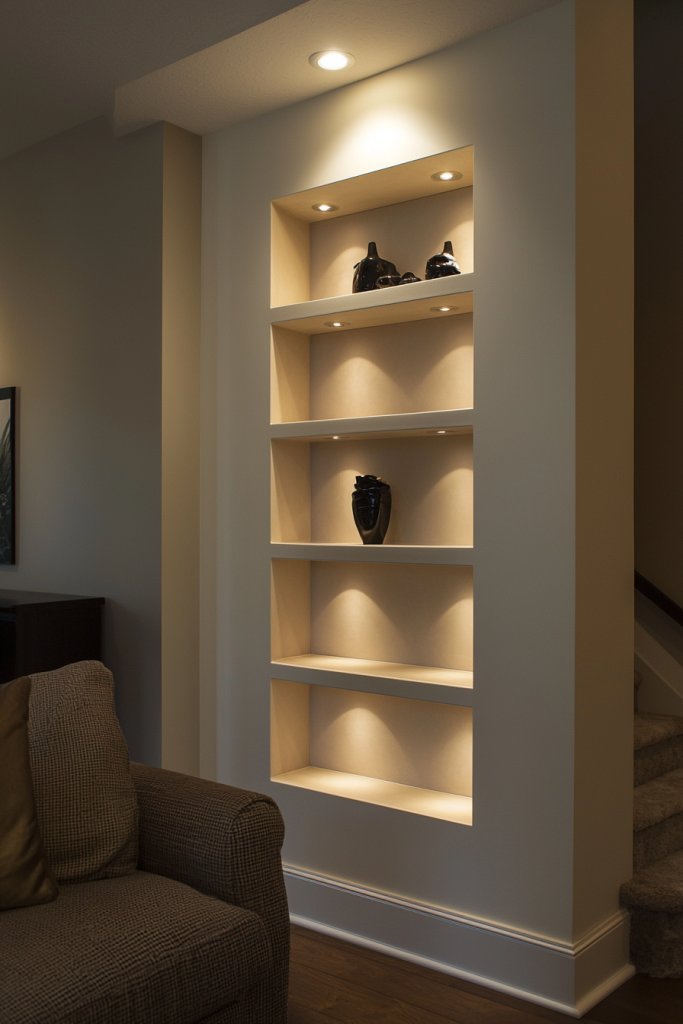
Maximizing wall space is essential in small living rooms, and built-in shelving and niches are perfect solutions that blend functionality with sleek design. These features create a seamless, integrated look that keeps clutter off the floor while adding personality to your space. They’re especially popular in modern, minimalist interiors where every inch counts.
Imagine a wall with custom-built shelves in a soft matte white finish, holding a curated collection of books, decorative ceramics, and small sculptures. Niches are recessed into the wall, painted in a contrasting pastel hue, showcasing cherished mementos or favorite art pieces. The shelving unit’s clean lines and hidden wiring give the room a tidy, spacious feel, while textured woven baskets within the shelves add warmth and visual interest. The overall effect is both practical and aesthetically pleasing, making the wall a focal point without overwhelming the room.
To recreate this look, start by assessing your wall space and deciding how many shelves or niches you need. Use sturdy wood or MDF boards for shelves, which can be painted or left natural, and consider installing recessed niches during a wall renovation or with a DIY drywall cutout. Secure the shelving with brackets or a cleat system, and finish with simple, modern hardware. Keep decorative items minimal but meaningful for a balanced, clutter-free appearance.
17. Minimalist Decor with Focused Accent Pieces

In small spaces, less truly is more, and a minimalist decor approach helps create a calm, open atmosphere. Instead of filling every surface, choose a few carefully curated accent pieces that bring personality without crowding the room. This strategy emphasizes quality over quantity, making your living room feel airy and sophisticated.
Picture a soft neutral-colored sofa draped with a chunky knit throw in a warm beige. A single statement sculpture or a sleek ceramic vase on a side table adds visual interest without cluttering. A small, textured rug in muted tones anchors the space, while a few decorative cushions in rich fabrics like velvet or linen add cozy layers. The room feels uncluttered but inviting, with each accent piece thoughtfully chosen to complement the overall aesthetic and enhance the room’s harmony.
To implement this, start by selecting a neutral color palette—think shades of cream, taupe, or soft gray—and stick to it across your decor. Choose one or two statement pieces, such as a bold geometric lamp or a sculptural bowl, and keep other accessories minimal. Avoid overcrowding surfaces; instead, let each item serve a purpose or contribute to the room’s visual story. This focused approach makes your small living room feel spacious and stylish.
18. Under-Window Seating and Storage Solutions
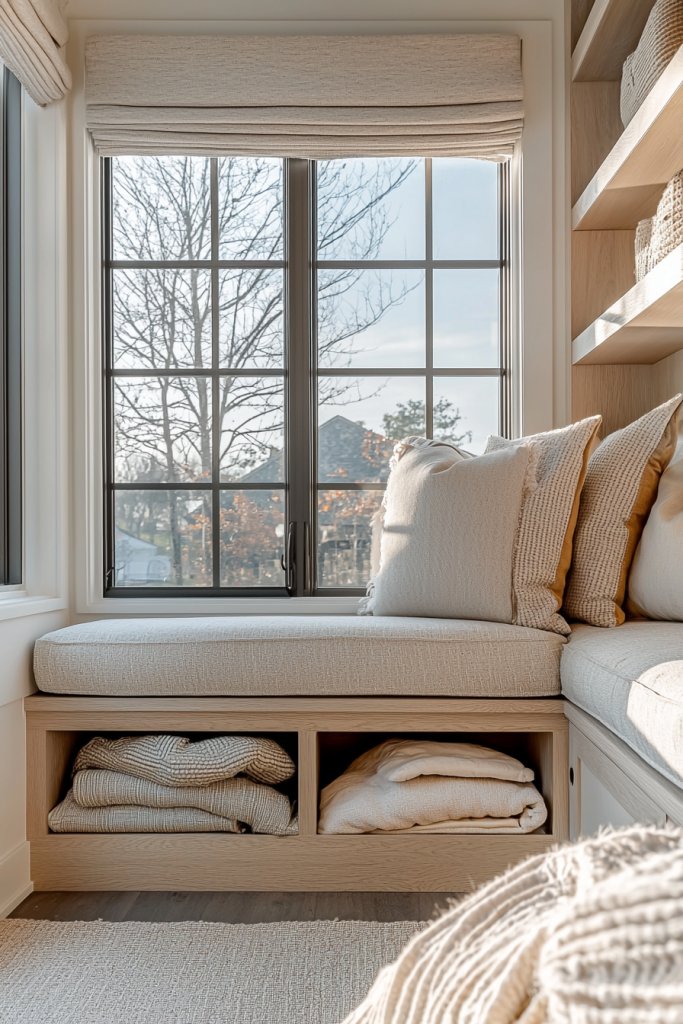
Utilizing space beneath windows for seating and storage is a clever way to maximize small living rooms. This dual-purpose solution provides cozy seating areas while offering extra storage for blankets, books, or other essentials, keeping the space tidy and functional.
Visualize a built-in bench with a cushioned top in soft, washable fabric like linen or velvet, placed beneath a large window. The bench has hidden compartments or drawers underneath, which can hold throws, magazines, or small decorative boxes. The cushion is topped with a few textured pillows in contrasting shades—perhaps a plush velvet in deep emerald or a woven lumbar pillow—to elevate comfort and style. The window sill remains clear, allowing natural light to flood the space, making the room feel larger and more inviting.
To create this setup, measure the width and height of your window to build a custom bench or purchase a ready-made window seat with storage options. Use a sturdy wood or MDF base for the seat frame, and add a comfortable foam cushion covered in durable fabric. Incorporate pull-out drawers or hinged lids for hidden storage. Finish with decorative pillows and a soft throw to complete the cozy look, transforming an unused area into a functional centerpiece.
19. Use of Light-Reflecting Surfaces to Enhance Brightness
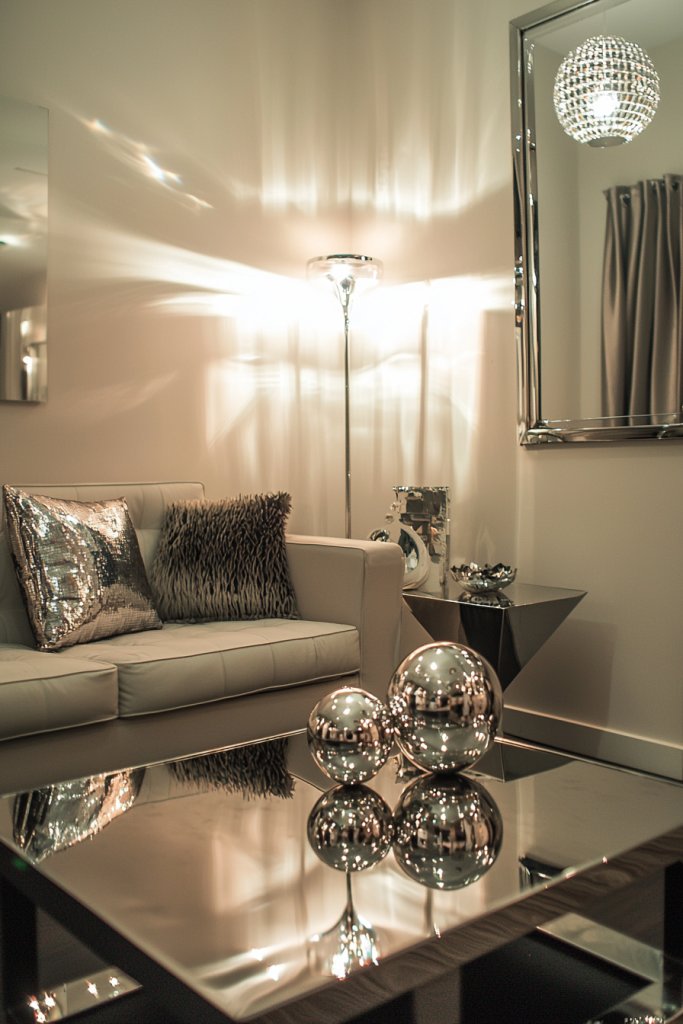
Brightening up a small living room instantly makes it feel larger and more welcoming. Light-reflecting surfaces—such as glossy finishes, mirrors, and metallic accents—are key tools for amplifying natural and artificial light, creating an airy, open atmosphere.
Imagine a wall-mounted mirror with a sleek, frameless design that doubles as a focal point, bouncing light across the room. Complement this with a glossy coffee table in a neutral tone or a metallic side table in brushed brass, which reflects light and adds subtle shine. Light-colored, textured curtains in sheer fabric allow sunlight to filter in softly, while a plush, cream-colored sofa with a subtle sheen enhances the reflective quality of the space. The overall effect is a luminous, inviting environment that feels more expansive than its actual size.
To incorporate this concept, choose mirrors, glossy or lacquered furniture, and metallic accents that catch and reflect light. Position mirrors opposite windows or light sources to maximize brightness. Use light, neutral-colored textiles with a slight sheen—like satin or silk—for curtains, cushions, or throws. Combining these elements creates a vibrant, open vibe that makes your small living room feel larger and more comfortable.
20. Compact Accent Chairs with a Bold Style Statement

In small living rooms, choosing the right accent chair can add personality without sacrificing space. Compact, stylish chairs in bold colors or interesting shapes serve as eye-catching focal points and functional seating options, elevating your decor with minimal footprint.
Picture a sleek, mid-century modern armchair in a vibrant teal or mustard yellow, with tapered wooden legs and a curved silhouette. The size is perfect to tuck into a corner or beside the sofa, adding a splash of color and visual interest. The fabric is soft and textured—perhaps a linen blend or boucle—to invite touch and comfort. Paired with a small side table and a statement lamp, this chair transforms a simple corner into a cozy nook that feels both lively and balanced, making your small living room feel dynamic and inviting.
To achieve this look, select a compact accent chair with a distinctive shape and bold color—look for options in stores or online that fit your space. Ensure it’s proportionate to your room, avoiding oversized pieces that can overwhelm. Pair it with a small side table or a decorative pouf to create versatility. Keep the surrounding decor simple, allowing the chair to stand out as a focal point that adds character and style to your small living space.
21. Smart Lighting Strategies to Increase Perceived Space
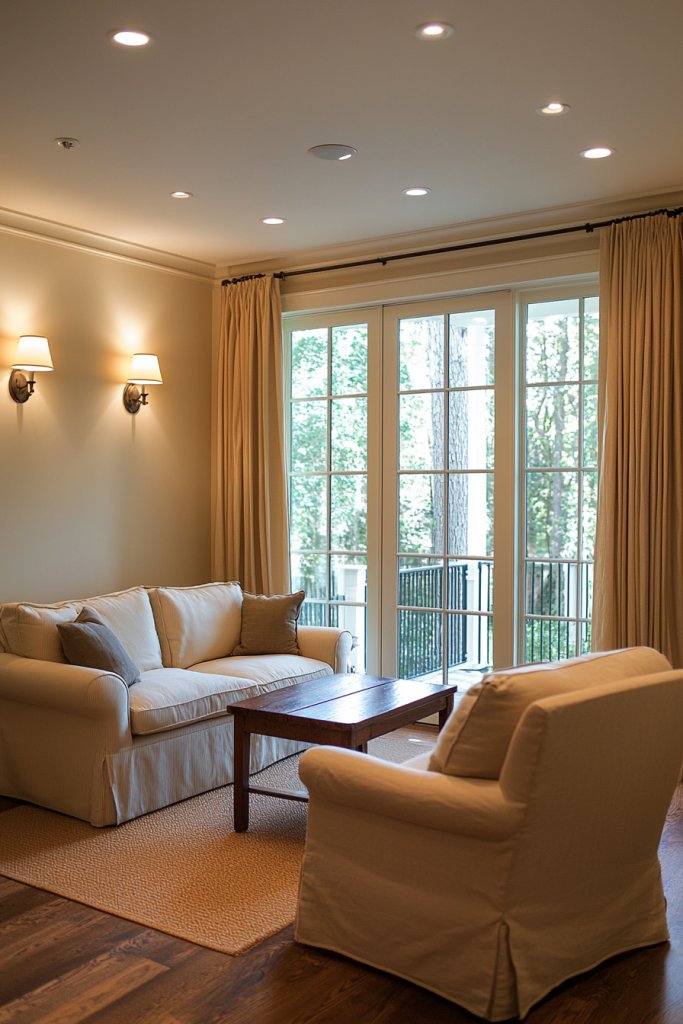
Good lighting can make a small living room feel much larger and more inviting. Smart lighting strategies use both natural and artificial sources to brighten the space evenly, eliminating shadows and creating an airy atmosphere that visually expands the room. When well-executed, lighting becomes an invisible enhancer, making your small living room feel open and welcoming.
Imagine a room with large, sheer window curtains that maximize daylight, complemented by sleek, wall-mounted LED fixtures that cast a warm, diffused glow. Incorporate adjustable floor lamps or table lamps with soft white bulbs to add layers of light, eliminating dark corners. Using dimmable lights allows you to adjust ambiance for movies, cozy evenings, or lively gatherings. Strategic placement of lighting near mirrors or reflective surfaces amplifies brightness and depth, further enhancing the perception of space.
To implement these strategies, start by installing a combination of ceiling-mounted fixtures, such as flush-mount or semi-flush lights, and wall-mounted sconces. Use energy-efficient LED bulbs with a color temperature around 2700K to 3000K for warmth and versatility. Incorporate plug-in or hardwired dimmers for flexibility, and consider adding a large mirror opposite a window to bounce natural light around. Simple, affordable options like clip-on lamps or battery-operated LED strips can also add extra layers without major renovations.
22. Open-Concept Layouts with Minimal Dividers
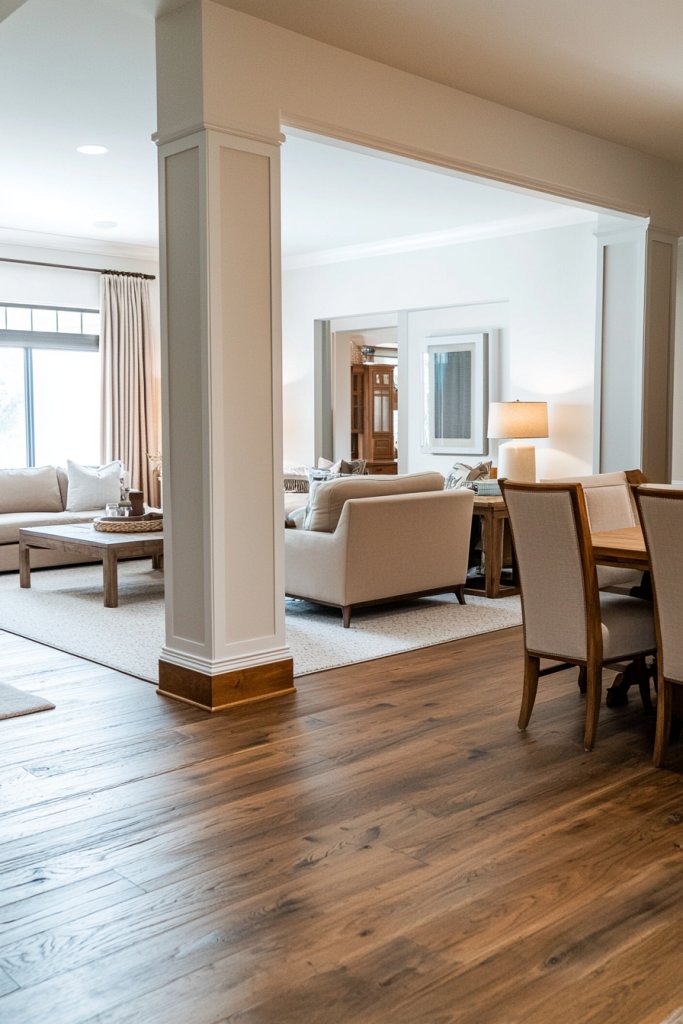
Creating an open-concept living area is one of the most effective ways to make a small space feel expansive. By reducing partitions and visual barriers, you allow light and movement to flow freely, giving the illusion of a larger, more integrated space. This layout encourages social interaction and makes the room feel less cluttered.
Picture a living room with a sofa placed centrally, facing a compact TV stand, with no bulky bookcases or room dividers breaking the space. Instead, subtle area rugs define different zones—like a plush gray rug under the seating area and a smaller, textured one near the entry. Using furniture with slim profiles, such as a streamlined sectional or a minimalist coffee table, further enhances the sense of openness. Light, neutral colors on walls and furniture keep the space feeling airy, while a cohesive design language unifies the entire room.
To adopt this style, begin by removing unnecessary walls or partitions if possible, or opt for furniture arrangements that maximize openness—like floating sofas or low-profile shelving. Use consistent flooring throughout to unify zones visually. Keep clutter to a minimum with smart storage solutions, and choose transparent or light-colored furniture pieces to avoid visual heaviness. Incorporate open shelving or wall-mounted units instead of bulky cabinets to maintain the spacious feel.
23. Creative Use of Hidden Compartments in Furniture
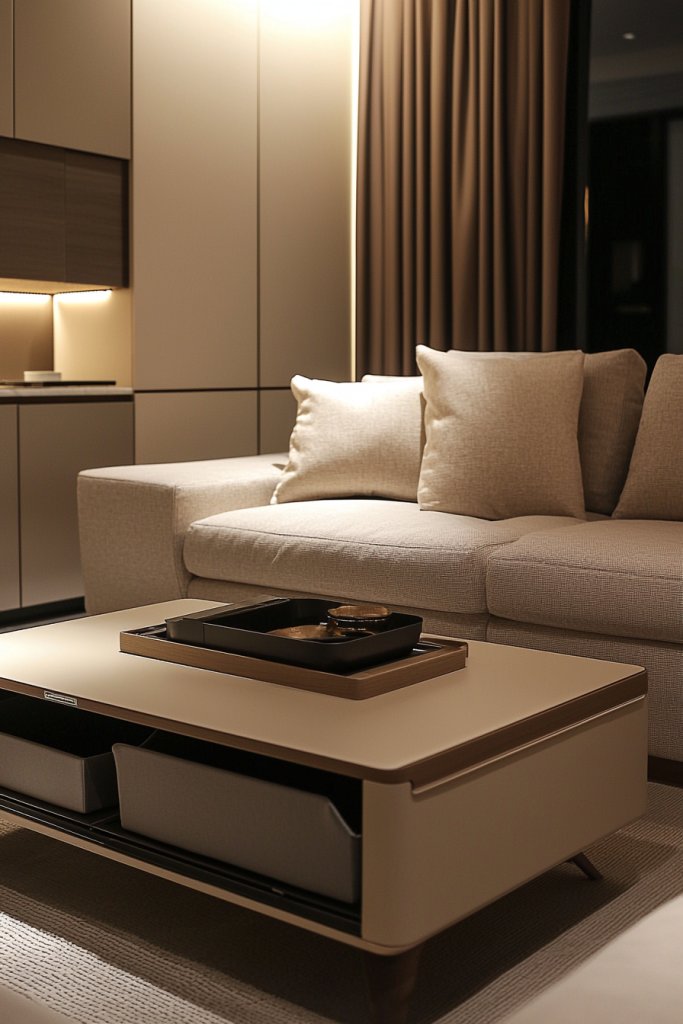
Maximizing storage in a small living room often means thinking outside the box—hidden compartments in furniture are a clever way to keep clutter out of sight while maintaining a clean, streamlined aesthetic. These discreet storage spaces can be integrated into coffee tables, sofas, or sideboards, helping you make the most of every inch.
Visualize a sleek, modern coffee table with a lift-up top that reveals a hidden compartment for magazines, remotes, or blankets. Or a multi-purpose sofa with built-in storage under the seat cushions for pillows or seasonal decor. These pieces often feature smooth, minimalist exteriors with subtle seams or hinges, blending seamlessly into the room’s design. The secret is that they serve both functional and aesthetic purposes, maintaining a clutter-free environment that feels spacious and tidy.
To incorporate hidden compartments, look for furniture with built-in storage options or consider DIY solutions like adding a hollow space inside an existing piece. For a quick fix, choose ottomans or coffee tables with removable tops or hinged lids made from durable materials like wood, MDF, or acrylic. Keep in mind safety—ensure hinges and latches are secure—and choose pieces that match your style, whether modern, rustic, or eclectic. These hidden gems make a big difference in small living rooms, offering clever, clutter-busting solutions.
24. Incorporating Textiles and Layered Textures for Warmth Without Bulk
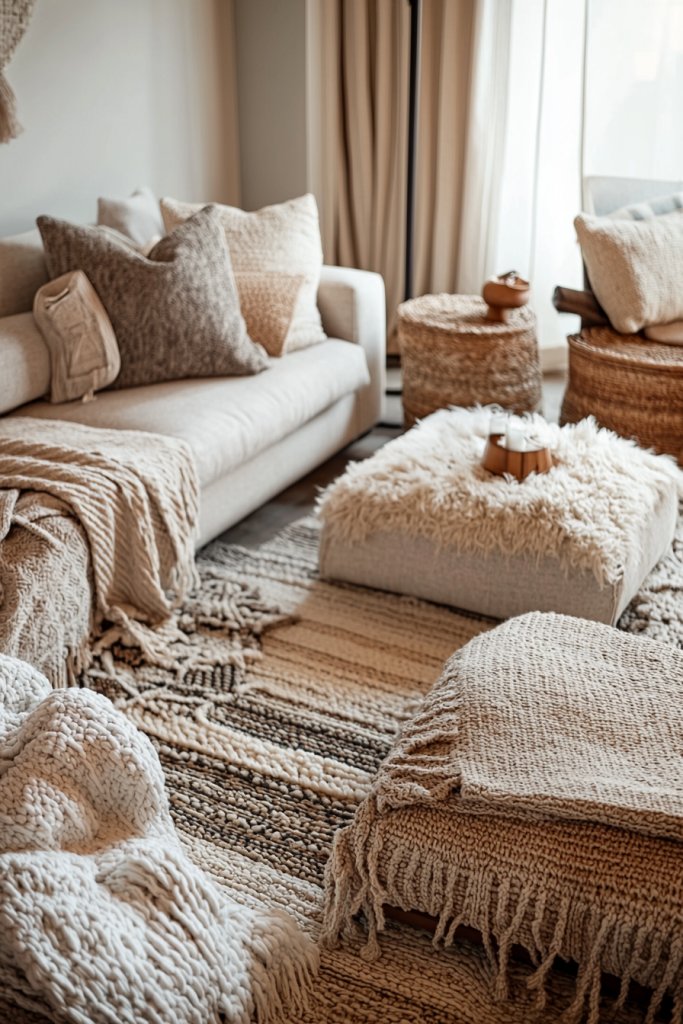
Adding textiles and layered textures is a fantastic way to create a cozy, inviting atmosphere in a small living room without making it feel cramped. Combining different fabrics—like plush throws, soft cushions, and textured rugs—adds visual interest and tactile warmth, making the space feel layered and welcoming.
Picture a soft, cream-colored linen sofa adorned with a chunky knit throw in warm beige and a variety of textured cushions in velvet, boucle, or woven fabrics. Layered rugs—such as a jute or shaggy rug paired with a smaller, patterned accent rug—define zones and add depth. Incorporate textiles in window treatments, like light, airy curtains or Roman blinds, to soften the room’s edges and diffuse natural light. These elements create a cozy cocoon effect, making your small living space feel warm and layered without adding unnecessary bulk.
To implement this, start with a neutral base—like a light-colored sofa—and build up with textiles in different textures and patterns. Choose lightweight, breathable fabrics that add softness without weight, and opt for multi-layered arrangements that can be swapped seasonally. Incorporate tactile accents such as a soft throw blanket, textured cushions, or woven baskets for storage. This layered approach enhances comfort and visual richness while maintaining a sense of spaciousness, making your small living room both stylish and snug.
Conclusion
By exploring a variety of clever solutions—from multi-functional furniture and vertical storage to light-reflecting surfaces and minimalist decor—this guide offers endless inspiration for transforming small living rooms into efficient, stylish spaces. Don’t hesitate to experiment with these ideas and tailor them to your unique needs, creating a cozy yet functional haven. With a little creativity and strategic planning, you can maximize every inch and make your small space feel larger and more inviting. Start transforming your living room today and enjoy the perfect blend of style and practicality!
Leave a Reply